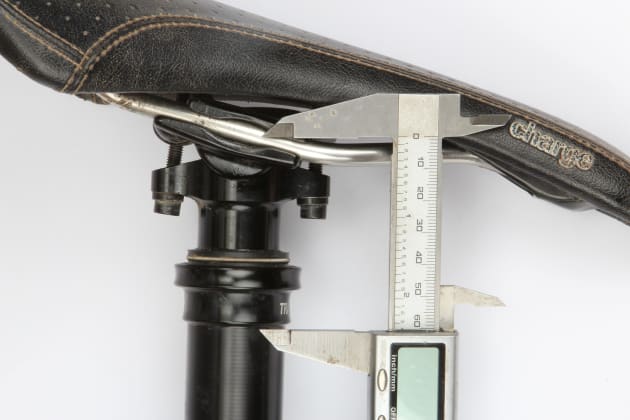Five Dropper Posts Reviewed!
We constantly hear marketing guff trotted out about such-and-such being a game changer. While much of this has no real foundation, we feel that the sport has seen a few true game changers over the years. For our money they would have to be disc brakes, suspension and dropper posts; we rate each of these as a real innovation that has genuinely improved the way our bikes ride.
While most accept disc brakes and suspension, dropper posts are a more recent addition and many people still think they are only of use if you ride down steep stuff. Take full advantage of a dropper and it will allow you to corner better and boost your confidence through any technical terrain, even if it’s flat. The key is remembering to use it and adapting your riding style to take advantage of the lower saddle height. Give it some time and I doubt you’ll want to go back to a fixed height post.
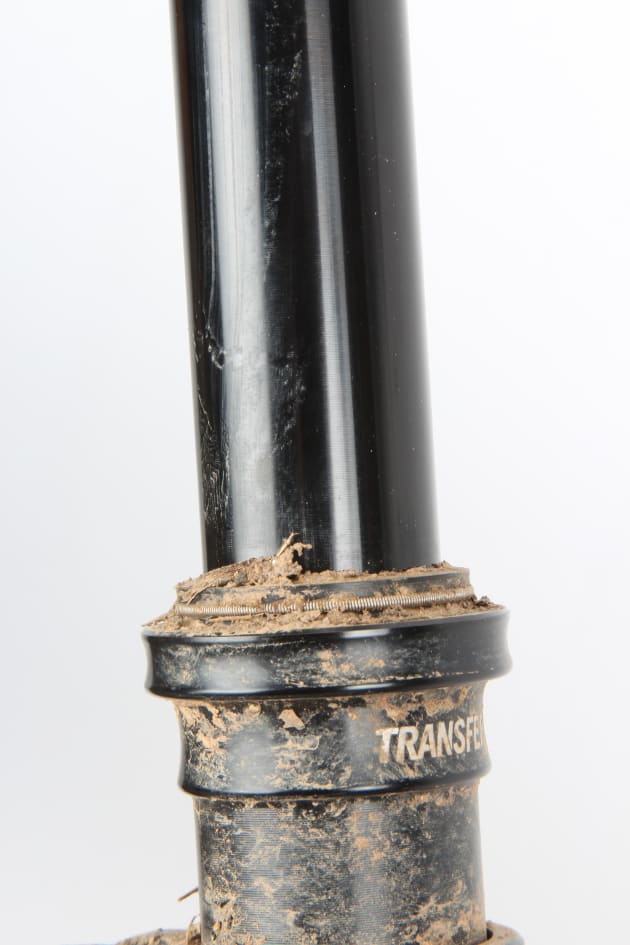
There is now a rapidly growing number of dropper options, so we gathered together a few of the newest models to test. Of these, three are totally new (Magura Vyron, Crank Brothers Highline and Fox Transfer) while other two are updates on longstanding designs (the RockShox Reverb and KS Lev Integra). Of course this is a small percentage of the market, and RaceFace, eThirteen, Shimano, Ritchey, X-Fusion and others have also launched new models. We simply nabbed the new model posts that were available to us at the time.
For this group review we’ve measured, weighed, compared and ridden each post in a wide range of conditions. While this certainly doesn’t constitute a long-term reliability test, we’ve done a lot more than just regurgitate the catalogue spiel.
Most of the specifications listed in the specs table are self-explanatory but some points need clarification.
Here’s a brief rundown:
Price: As always this will vary from one store to the next. In some cases, the bar remote that’s selected will influence the price; in these cases we’ve listed the value as reviewed, including any optional extras.
Weight: We’ve included two weight columns; the first is just for the post and the other includes the cable and handlebar remote as well. All posts were weighed in the 31.6mm diameter but in some cases the length varied, which will influence the outcome for those models.
Minimum Ride Height: This measurement is taken from the centre of the seat rails to the base of the collar, just below the seal head. A more compact dimension allows for a lower total ride height; a handy thing to look for if you’re trying to fit the longest possible dropper, or simply have a bike with a relatively tall seat tube that doesn’t leave a lot of seatpost exposed.
Total Length: This is taken from the saddle rails to end of round section when the post is fully extended. It becomes an important consideration on bikes with bent or interrupted seat tubes. If this dimension doesn’t allow you to drop the saddle low enough, you may need to opt for a shorter travel post. Note that we didn’t include the actuator mechanism in this measurement; while it hangs a bit lower, it’s a smaller diameter and usually doesn’t interfere.
Drop Force: We used a digital hanging scale to measure the force required to drop the saddle all the way down to the bottom. Where the air spring is adjustable, we used an intermediate setting. The force required to drop the post won’t be a major issue for bigger riders but it’s worth considering if you’re reasonably light or just prefer a post that takes minimal effort to drop.
Initial Setup: Rated on a scale from one to 10 where 10 is the absolute easiest to fit and one requires a degree in rocket surgery.
Ease of Removal: Once again rated up to 10 where the highest score is best. With this we’re considering removal and refitting as you may need to do for air travel or sending the post off for servicing.

Fox Transfer $558
The Transfer is an all new design from Fox that supersedes their original DOSS dropper. Unlike the three position DOSS, the Transfer features infinite height adjustment and a far more compact handlebar remote. We’d go as far as saying the new lever was the tidiest and most compact of all the under-bar levers that we looked at—a vast change from the behemoth that accompanied the DOSS! Aside from its compact sizing, it offers a simple but useful adjustment range and points the cable in the right general direction.
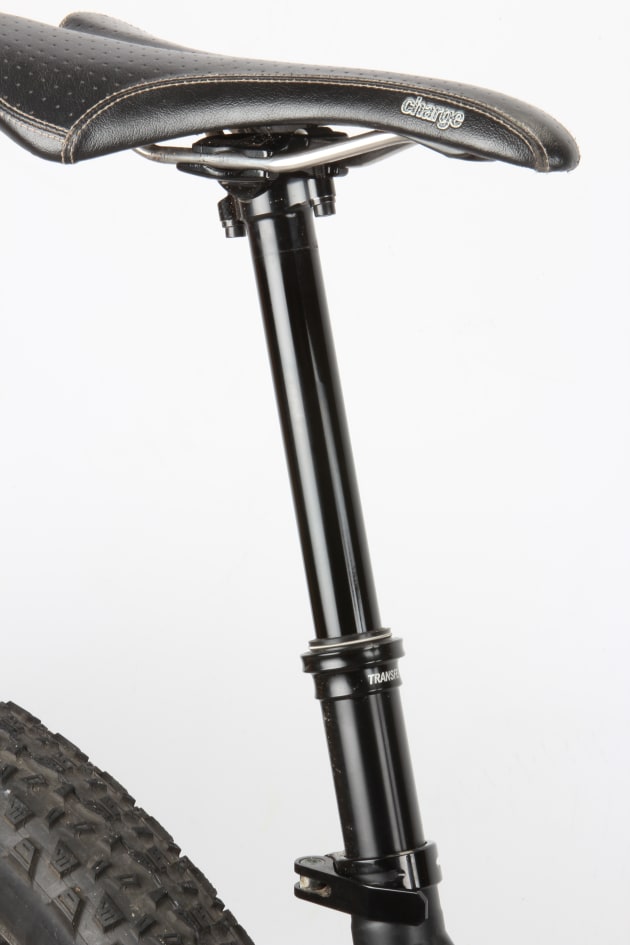
We tested the more affordable ‘Performance’ version – that’s the all-black one – but Fox also offers a Factory level post that costs around $70 more ($527 versus $459 for the post alone). Both rely on the same cartridge and internals but the Factory level post has a machined outer tube and gold Kashima coating on the inner tube—it may be fractionally smoother but more importantly it’ll match up with any other Factory level Fox items you may own!
With Fox, the post and lever are sold separately. You can choose between two remote options; the under bar style that we tested as well as a slim 2X or 3X compatible version that can be mounted on either side of the bars. While we tested the internally routed version, they also offer an externally routed Transfer; with this the cable stops at the lower part of the post so it doesn’t move when the saddle position is adjusted—a tidy option.

When it comes to the initial setup, this is one of the easiest droppers to deal with. The cable head slips through a small barrel before being fed up to the lever where it’s clamped by a neatly hidden grub screw. Clamping and trimming the inner wire was easy to do up at the lever and the system was not finicky when it came to setting the cable tension. Removing and refitting the post was easy too; cable removal is self-explanatory and the barrel pops easily out of the actuator. As with all of the posts on review, the Transfer has a two-bolt head. It was well made, easy to adjust and didn’t creak. Our post measured 460mm fully extended; that’s on the long side for a 150mm dropper—something to be mindful of if you’ve got a frame with limited seat tube insertion.
With our under bar lever, the action was reasonably light with quite a short throw. It didn’t require much weight to drop the saddle and the factory set rebound speed was snappy and responsive without being disconcerting. The speed can be controlled to some extent via the remote; pushing the lever in a little bit less leads to a slower rebound and it’s easy to stop the post halfway up if you want.
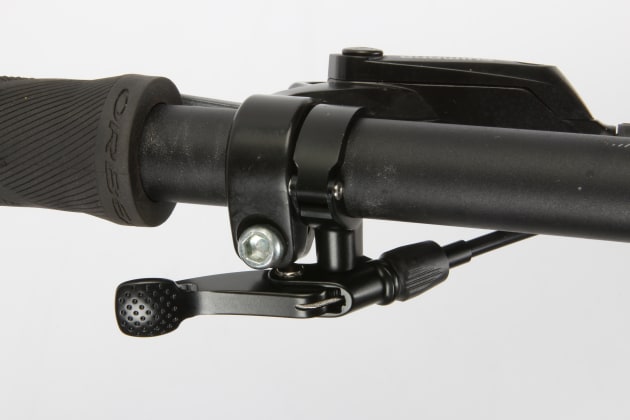
Both top-out and bottom out on the post come with an audible clunk; in use I found this reassuring as you were never in doubt that the saddle had reached the end of its travel in either direction. Additionally, when the post is lowered you can still lift the bike by the saddle; it won’t move or do any harm to the internals as can happen with other designs.
While it’s the heaviest dropper we looked at, it’s only 64g more than the lightest one, so there really isn’t much in it. Some may prefer a slower rebound speed but we liked the snappy action and feedback that the Transfer gives—it’s fast, intuitive and very easy to control. This combined with the ease of setup made it one of our favourites. The Performance series post also happens to be one of the more affordable posts, which certainly doesn’t hurt. Top marks for Fox!
Sola Sport (02) 9550 1655 / www.ridefox.com
KS Lev Integra $550
The Lev Integra isn’t an all-new design but the 2017 model that we reviewed does have some new features. Most conspicuous of these is the added travel and we tried the new post with 175mm of drop—it’s huge!
Aside from this, the latest Lev Integra also has a few internal updates aimed at improving its reliability. In this case reliability is something that we can comment on, as one of our reviewers runs a Lev Integra on their own bike and has had it for over two years now. In this time the post hasn’t presented any real problems and only required general maintenance (intermittent lubing of the main seal and cable replacement).
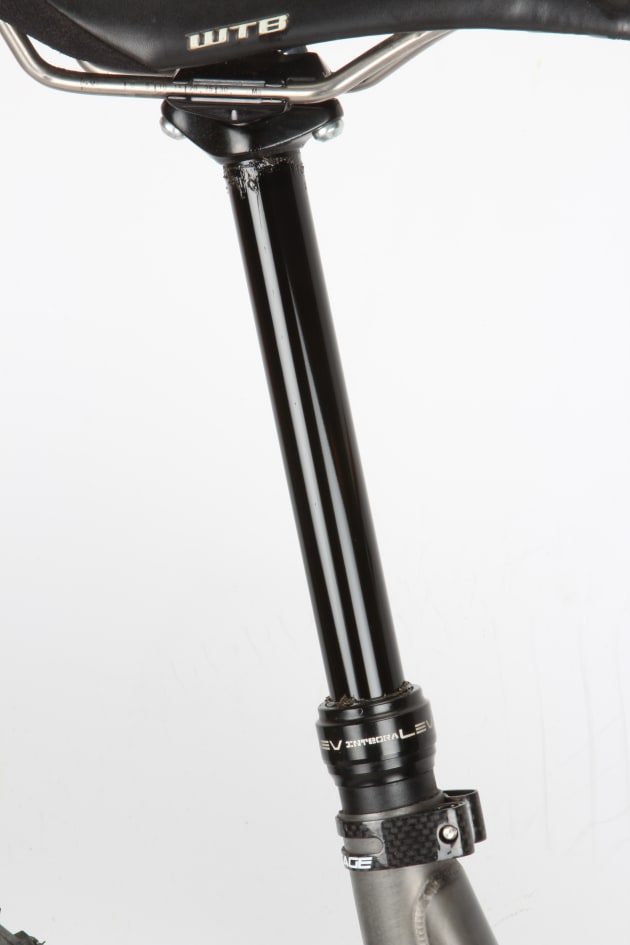
That’s not to say that some Lev owners haven’t had problems and we have heard of some posts dumping oil from the cartridge. KS is clearly aware of these issues and the newest models have a revised profile at the end of the cartridge that stops the base plate coming adrift. They’ve also updated the guide rods to reduce side play at the saddle, a modification that can be retrofitted to existing posts. While the latest models have undergone refinements, it’s not like the post was crying out for help.
When mounting the Lev Integra, the cable goes in at the handlebar remote and attaches to a small barrel via a grub screw down at the actuator on the base of the seatpost. You can’t have any excess cable protruding beyond the barrel, so the cable length needs to be calculated and cut before installing the barrel. KS supplies all the instructions but it’s not as straightforward as the other cable-actuated posts that we tried where inner wire is clamped up at the remote (Transfer and Highline). Once you get past the initial install, removing and refitting the post was easy; the cable simply unhooks from the claw on the base of the dropper.
At 637g including the Southpaw remote, the Lev Integra is impressively light for a 175mm dropper. We also put a 150mm Integra on the scales and it came in at 595g (including the remote), so length-for-length the Integra is the lightest post we reviewed. In stock form the 175mm Integra sells for $550 while the 100/125mm versions are $450 and it's $500 for the 150mm travel Lev. This includes their slim mount lever; it sits right next to the grip and even integrates with some lock-on grips. KS also offers their under-bar 1X specific Southpaw remote as an aftermarket upgrade — this ads $70 to the price. We used it with the Southpaw to keep it consistent with the others on test.

The lever action is nice and light with the Lev and dropping the post requires minimal effort too; overall it offered the lightest feel out of the review group—an excellent option for flyweight riders. While it’s not externally adjustable, the rebound speed can be varied quite a bit by altering the air pressure. Don’t pick the bike up from the saddle when it’s in the dropped position however; the post will lift and it can cause the air and oil to mix.
As for the massive 175mm drop, we didn’t notice any real benefit over a 150mm post. While we have plenty of steep and technical trails in our area, 150mm drop has never limited our ability to move around on the bike (125mm drop has its limitations though). If you’re over 185cm tall, this is likely to be a different story. Riders with longer limbs are more likely to benefit from a long travel dropper but for most the 150mm option should suffice.
As this isn’t an all-new design, you can feel fairly safe that you won’t encounter any hidden surprises when it comes to reliability. The Lev Integra is a well-proven design that’s light on the scales and light in action—definitely a smooth operator.
Link Sports (02) 9560 7841 / www.linksports.com.au
Crank Brothers Highline $559
Let’s face it; the Kronolog didn’t do Crank Brothers any favours when it comes to dropper post reliability. Well they went back to the drawing board and the new Highline bears no mechanical or visual semblance to the ill-fated Kronolog. Where the Kronolog used mechanical jaws to lock the shaft in place, the Highline runs a fully sealed hydraulic cartridge. The finicky single bolt head has also been replaced by an easy to adjust twin-bolt design with a quick release rear mount, which makes the clamp a little easier to deal with. They’ve also fitted a brand name Trelleborg seal with Igus bearings/keyways and the whole thing is backed by a three-year warranty. At the moment, 125mm drop is the only option offered but apparently a 160mm post is in the works.

The universal lever is a clever piece of work. It can be mounted above or below the bars on either the left or right hand side. The unique swivelling ball on the clamping mechanism allows a wide range of angle adjustment and it’s all easily held in place via a single bolt.
The post comes with the cable pre-mounted in the removable nylon actuator assembly. All you need to do is feed the outer cable through, cut it to length and run the inner wire up to the lever. Once it’s pulled taut (just with your fingers) a grub screw locks it down. Cut off the excess, adjust the tension with the barrel adjustor and you’re done. There isn’t a huge amount of leeway in the cable tension; too tight and the post will creep up when the lever is released, too slack and the rebound speed will be excessively slow. That said, it wasn’t hard to get it right; just make the cable a bit too tight and then slacken it off until the post no longer creeps up—job done! Overall the Highline was one of the easier posts to install.

With its removable nylon actuator at the bottom, it was also easy to remove the post if required. Care needs to be taken however, as the threaded metal ring dangles loosely on the actuator once removed. From there it’s easily lost inside the seat tube which can be a real pain if it gets stuck on something whilst inside. Also, refitting involves lining up a keyway inside the post as well as aligning the actuator with the arrows on the body; not a hard task in itself but it can get a bit fiddly if you’ve not got a lot of spare cable poking out of the seat tube.
In use the remote lever requires a little more thumb pressure than some and you also need to place a bit more body weight on the saddle to drop it all the way down. At its fastest rebound setting, the return speed was still on the slow side; some may appreciate this while others will prefer a faster return—it’s all a matter of taste. Whatever the case, the action was very smooth and remained that way throughout the review. You can also pick the bike up by the saddle in the dropped position without the post lifting or being damaged.
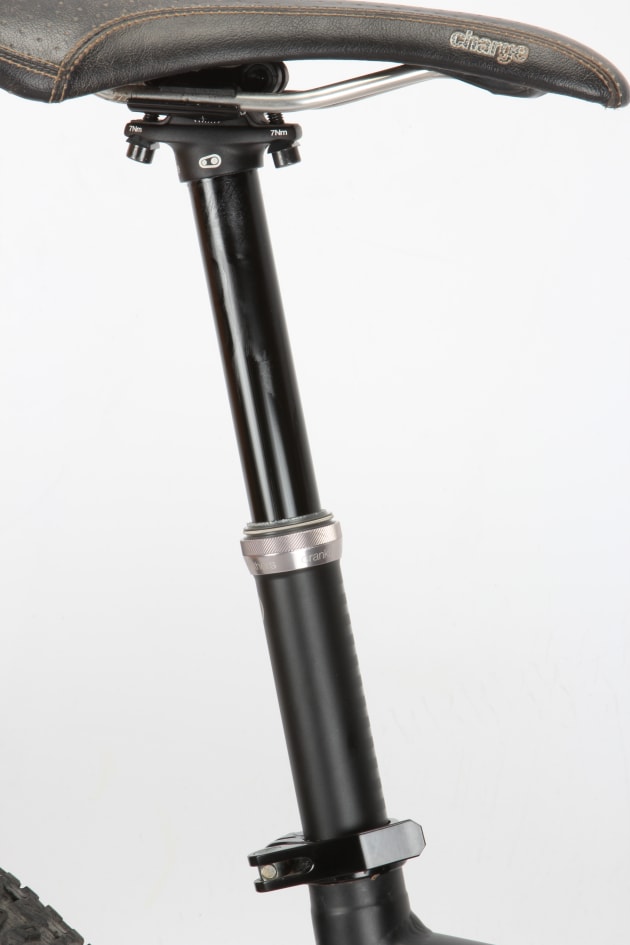
While the hydraulic cartridge isn’t serviceable, the rest of the post can be maintained by any competent home mechanic. The recommended service schedule has some very generous intervals too. Pop the threaded seal collar of to clean and grease every 150-175 hours with a major strip down after 450 hours or more—that’s far less intensive than most and an indication of how much confidence Crank Brothers has in their latest design.
Will it stand up in the long-term? Well we didn’t encounter any issues during our review and (unlike the Kronolog) the design appears to be well engineered and mechanically sound. Only time will tell but so far it seems to be as good as the competition from a reliability perspective.
Lusty Industries (02) 4962 3511 / www.lustyindustries.com
Magura Vyron eLECT $690
While it has just recently been joined by others that were announced at the Eurobike tradeshow, the Vyron was the first wireless electronic dropper to hit the market. What’s the big deal? Well it means the Vyron will fit just about any bike and it totally sidesteps issues awkward internal cable routing or bikes that weren’t designed with dropper posts in mind.
The Vyron consists of a post with an ANT+ remote and it charges via a regular mini-USB cable (the remote uses a small watch-style battery). The remote simply straps to the handlebar with a rubber O-ring, then you fit the post like a regular fixed height unit. Pair the post with the remote and you’re set. It’s by far the easiest dropper to fit and removal is just as simple. If you’ve got a few different bikes with the same seat tube diameter, it’s even feasible to swap the post from one to the next.
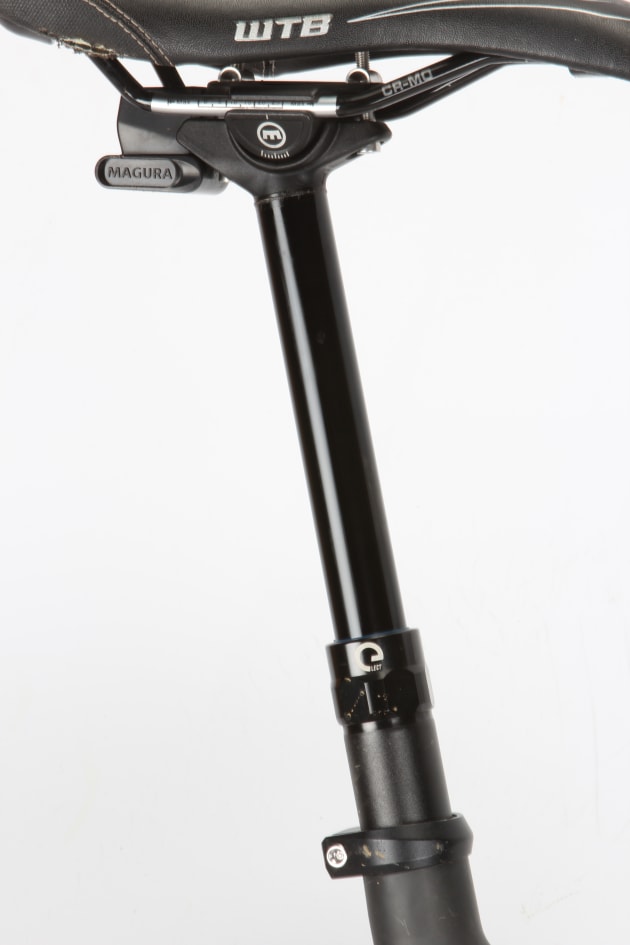
The post takes around three hours to charge and with average use it should go for months (Magura claims around 400 actuations). Ours was still going strong after two months of use on the initial charge. Visually the post looks pretty normal; the small box at the rear is the only giveaway. The remote looks a little chunky too but that’s offset by the general lack of cables at the front end which is nice.
The remote actually incorporates three buttons. The middle one is for the dropper while the other two are optional; they can be connected to a Magura fork and rear shock to control the lockout function. As it stands, the middle button isn’t a big one but we got used to this and were still able to locate it easily enough on the trail. To make the dropper button easier to hit for fat-fingered riders, Magura is soon to release a cover that makes the button larger and more tactile—a worthwhile addition if you’re not using the suspension remote buttons.
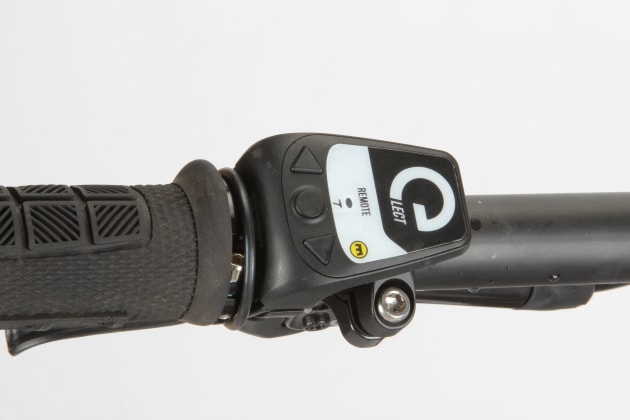
The return of the post is still controlled by an air spring and you still need to sit on the saddle to lower it—just like a regular dropper. In use however, the electronic actuation was clearly different. After pushing the button, there’s a half second or so delay before the locking mechanism opens up. The post is then free to move for around a second before shutting off again. There’s definitely a learning curve if you’re used to a mechanical post, which is free to move as soon as you depress the lever and then locks the instant you release it.
Half a second mightn’t sound like much but it can seem like an eternity when you’re heading for an unexpected drop at speed. Give it time and you do adapt to the timing and action of the Vyron—you just need to rewire your brain and get used to the timing. While it was never as fast as a more traditional post in those ‘oh shoot’ moments, it was certainly a viable and workable solution. If you’re the sort of rider who pedals up a sustained climb and then drops the saddle for an extended descent, the Vyron won’t pose any problems at all.

The rebound speed is relatively sedate and unthreatening. This can be adjusted via the internal air pressure but even at the fastest setting, the Vyron remained at the slower end of the scale. You should also avoid lifting the bike by the saddle with the Vyron; the saddle will lift and it’s generally not recommended by Magura.
The Vyron offers a clean and effective solution that removes all of the mounting hassles that come with regular droppers. While some may be sceptical of electronics on mountain bikes, it seems that Magura has nailed the mechanics and the Vyron proved totally reliable throughout our testing.
Eurocycles (02) 9420 9480 / www.magura.com
RockShox Reverb $699
The Reverb is as old as the hills. While it’s not the first of its kind by any stretch, it’s safe to say this is the dropper that really brought height adjustable posts to the mainstream. It’s also the post that you’re most likely to see as original spec on mid-to-upper-end mountain bikes.
I’ve used Reverbs on many of my bikes and, while they haven’t been entirely trouble-free, they’ve been reliable for the most part. I had one post that developed 5mm of ‘sag’ at the top of its travel and needed servicing as a result. I’ve also bled numerous hydraulic remotes along the way—something that many find intimidating but really isn’t a big deal. As with anything you get both good and bad examples but overall I’d class the Reverb as a reliable dropper post.

All that relates to the old Reverb and RockShox has since revamped it completely. Overall the mechanics remain unchanged; it’s still an air assisted hydraulically actuated post with a hydraulic handlebar remote. What has changed is the internals. First up the bushings are spaced further apart; this provides better support for the telescoping part of the post and it’s less likely to develop fore-aft play. This in turn places less stress on the seals and improves durability. It has also allowed RockShox to introduce a 170mm travel Reverb to complement their existing 100, 125 and 150mm options. The 150mm dropper is now available in a 30.9mm diameter too (previously you had to use a 31.6mm size to get the longer travel option).
With assistance from seal and bearing specialists SKF, they have also developed a new floating piston. It’s quite an elaborate seal design that aims to keep the air and oil separate no matter what. This should eliminate the sinking saddle issue that I encountered with one of my older Reverbs. While the post will still lift if you pick the bike up by the saddle, RockShox is quite confident that it won’t hurt the function of the post. The new floating piston can be retrofitted to the older models too—worth asking for if you need a service on your older Reverb.
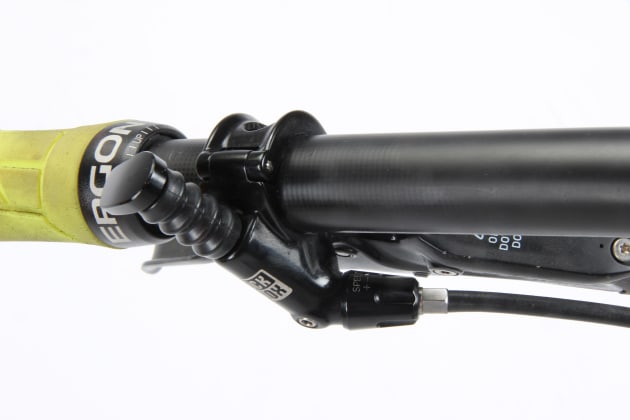
While the internals have changed markedly, the feel and action remains virtually unchanged. Visually it looks identical too. The remote fits neatly when paired to SRAM brake levers but it doesn’t always tie in neatly when used with third party brakes. It’s also side specific with two options; top-right/bottom-left or top-left only. As a result, the remote isn’t as flexible as some.
Some people may be put off by the prospect of bleeding the remote but it isn’t particularly hard. The ‘Connectamajig’ junction at the base of the post means it can be removed and refitted a few times without a bleed as well. Pushing the remote requires more finger-force than the mechanical levers that we had on test. The payback for this comes in really wet and muddy conditions where the fully-sealed hydraulics mean that the action remains totally consistent.

This post also requires more weight on the saddle to get it all the way down. It’s something that probably won’t bother you but it becomes immediately apparent when you hop on a competing product. When compared side-by-side with the older Reverb, the new version does feel slightly smoother with less stiction. The already broad range of rebound adjustment seems even broader too, with a super-snappy return available if you like it fast. As with the previous design, this tuning range achieved by a simple turn of the dial on the handlebar remote—no tools required.
While the improvements are not plainly obvious, the updates make this already solid dropper an even better prospect. It’s one of the few ultra-long travel posts on the market (a handy thing for really tall riders) and the hydraulic remote keeps things working consistently in all conditions—rain, hail or shine.
Monza Imports www.sram.com














